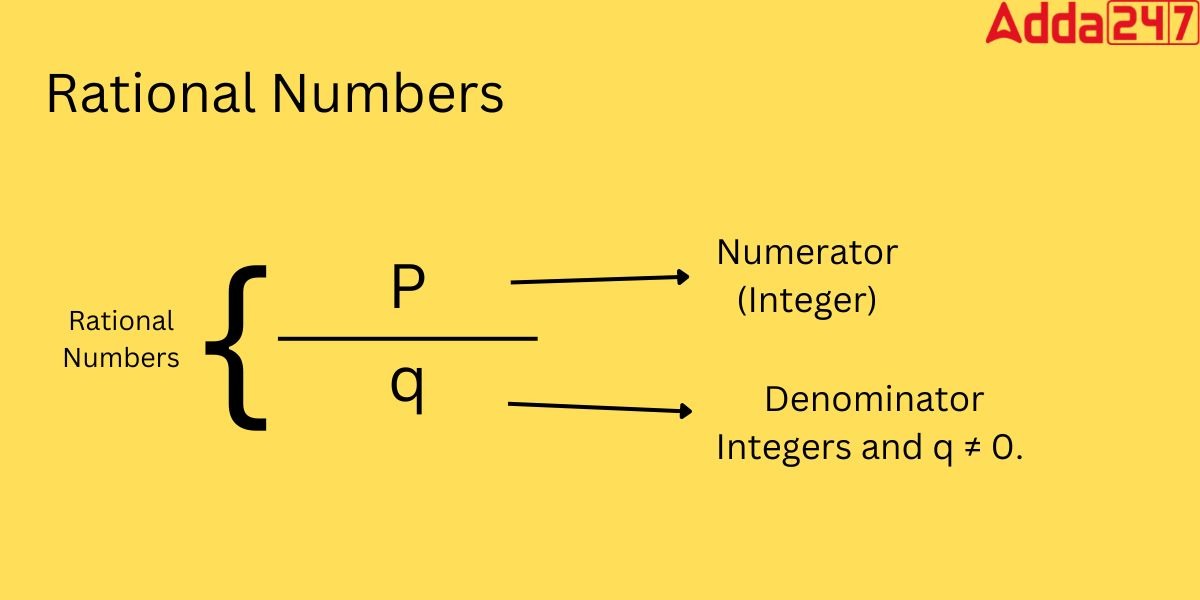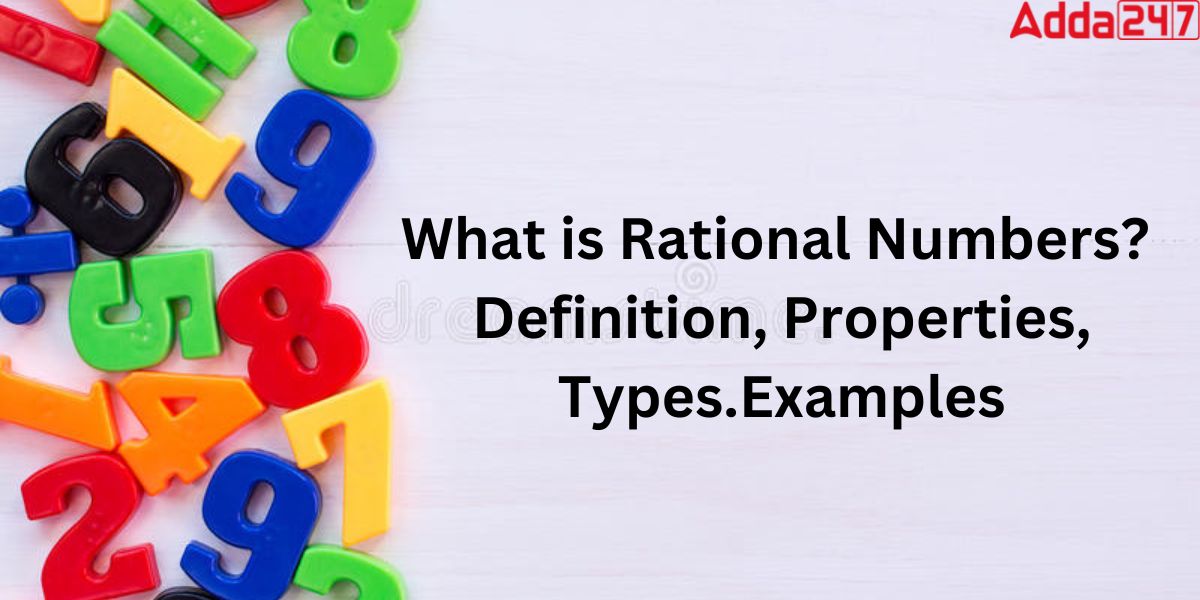In Mathematics, Rational Numbers are a type of number that can be represented in the form of p/q, where p and q can be any integer and q is not equal to zero. Thus, natural numbers, whole numbers, integers, fractions of integers, and decimals are all examples of such numbers. Let us know more about rational numbers, their types and properties, the difference between rational and irrational, and examples in this article.
Rational Numbers Definition
A rational number is any number that can be expressed as p/q, where q is not equal to 0. In other words, any fraction that has an integer denominator and numerator and a denominator that is not zero falls into the category of rational numbers. Some Examples are 1/6, 2/4, 1/3,4/7, etc
Rational Numbers Meaning
The term “rational Number” is derived from the word “ratio” in mathematics. Therefore, it is simple to grasp how rational numbers connect to the idea of fractions, which stand for ratios.
A rational number that can be expressed as a fraction and has an integer denominator and numerator and one that is not zero is said to be rational. A rational number can therefore be written as p/q, where p and q are both integers and q ≠ 0.
Rational Numbers are Denoted by Symbol
Rational numbers are the set of numbers in which numbers can express in form of friction or p/q form, where p and q both are integers and q is not equal not zero. The set of a rational number is denoted by Q, Look at the below image to get a clear idea of a rational Number,

Rational Numbers Examples
We came to know that any number can be expressed in a fraction where both the numerator and denominator are integers and the denominator ≠ 0. Some Examples of Rational numbers are
- 0 (which is another form of 0/1)
- 1/3
- √25 is equal to 5
- -3/4
- 0.54 or 54/100
- -0.8 or -8/10
- 87 which can be written as 87/1
- 0.181818… or 18/99
Is 0 a rational Number?
Yes,0 is a Rational Number. Since it may be expressed as a fraction of an integer like 0/1, 0/-2, etc., 0 is a rational number. We have various ways to represent the number “0,” including 0/1, 0/2, 0/3, etc. However, /0, 2/0, 3/0, etc. are not rational,
Types of Rational Numbers
There are different types of Rational Numbers as follows
- Both Positive and negative integers are examples of rational numbers. For instance 2.-3,
- This set of numbers includes fractions like 7/9, -3/5, etc. in which numerators and denominators are both integers, and the denominator is not equal to zero.
- These numbers include both types of decimals: 1) Terminating decimals, such as 0.89, 0.7656, and 0.345, etc which can be written in fractions.2)Non-terminating decimals with some repeating patterns, such as 0.666, 0.676767, etc.
Properties of Rational Numbers
The properties of Rational Numbers are
- Rational numbers can express in form of friction or p/q form, where p and q both are integers and q is not equal not zero.
- It is possible to represent the ratio p/q in decimal form, which is a further simplification.
- A set of rational numbers includes zero, positive, and negative numbers.
- Thus natural numbers, whole numbers, integers, fractions of integers, and decimals are all examples of such number.
Arithmetic Operations on Rational Numbers
The fundamental operations we carry out on integers to solve a numerical problem in mathematics are called arithmetic operations. Here, let’s talk about how to carry out these operations on such numbers. Consider two rational numbers.p/q and a/b.
- Addition: To add two rational numbers, we must note that the denominator needs to be the same.
Hence in the addition of p/q and a/b.we obtain, (pb+qa)/qb.
For Example: 1/3+ 2/9 = (3+2)/9 = 5/9 - Subtraction: In the Subtraction of two Rational Numbers, we must first make the denominator equal before doing the subtraction.
Hence in the Subtraction of p/q and a/b.we obtain, (pb-qa)/qb.
For Example:1/4 – 3/8 = (2-3)/8= -1/4 - Multiplication and division Operation: Rational numbers can be multiplied and divided in the same way as fractions. Any two rational integers can be multiplied by multiplying their numerators and denominators independently, then summing the resulting fraction. Let’s use an illustration to better grasp this.
Multiplication: If p/q is multiplied by a/b, then we obtain (p×a)/(q×b).
Example: 1/3 × 2/4 = (1×2)/(3×4) = 2/12=6
- Division: If p/q is divided by a/b, then it is written as:
(p/q)÷(a/b) = pb/qa
Example: 1/3÷ 2/9 = (1×9)/(3×2) = 9/6 = 3/2=1.5
Rational Numbers Representation
Rational numbers are numbers that can be expressed as a fraction of two integers, where the denominator is not zero. The set of such numbers is limitless in number line. As a result, it is impossible to compile a complete list of rational numbers. This demonstrates that all decimals (including terminating decimals and recurring decimal numbers), whole numbers, integers, fractions, and decimals are thought to be such types of numbers. For a better grasp of rational numbers, see the Venn diagram below.

- All rational numbers are real numbers (R) (Q).
- The integers are a part of real numbers (Z).
- Natural numbers are a part of integers (N).
- All whole numbers are rational because they can all be expressed as fractions.
Every Rational Number is a proper or Improper fraction
In the same way that whole numbers and integers are represented on the number line, rational numbers can be represented on the number line. The number zero (0) is known as the origin on the number line. The positive values are shown on the right side of the origin, whereas the negative values are shown on the left. Let’s look at how to express rational numbers on a number line now.
There are two main sorts of representations for rational numbers. The rational number can be expressed as a proper or improper fraction.
Representation of a Proper Fraction
If it’s a proper fraction, the numerator is smaller than the denominator, so the supplied rational number should be less than 1 and more than 0, and we can simply express it on the number line.
Representation of an Improper Fraction
Because the numerator is bigger than the denominator in an improper fraction, the given rational number should be greater than 1. In this scenario, turn the improper fraction into a mixed fraction first. This conversion aids in determining the precise location of a given fraction on the number line. It’s useful to know where the fraction falls between two integers.
Rational Numbers List
A rational number is one that can be written as a fraction with both the numerator and denominator being integers. Here are some examples of rational numbers:
- -13, 0
- 1/3
- -3/7
- 9 or 9/10
- -0.01 or -1/100
- 14/9
Some of the important examples are: 1/2, 3/4, -1/3, 5/8, 2/5, -3/7, 4/9, 6/11, -2/6, 7/10, -5/12, 9/13, 11/15, -4/5, 17/20, -6/7, 13/17, 8/11, -10/13, 15/19
Please note that this is just a small example sample of rational numbers, and there are infinitely many numbers in existence.
Rational Numbers and Irrational Numbers: The Difference
Irrational numbers are those that ARE NOT rational numbers. The difference between rational and irrational numbers
| Rational Numbers | Irrational Numbers |
| Rational numbers that can be represented using integer fractions. | Irrational Numbers are those that cannot be represented using integer fractions. |
| All natural numbers, all whole numbers, and all integers are included in the set of rational numbers. | The set of such numbers is an independent set that is devoid of any elements from the other sets of numbers. |
| These Numbers are terminating decimals. | They are never terminating decimals, Irrational Numbers have an inaccurate value |
| Examples- 1/3,1.414,0.56 etc | Examples- √7, π, etc. |
| Related Posts: | |
| Real Numbers | Natural Numbers: |
| Whole Numbers | Prime Numbers |









 NTA NEET Syllabus 2026 PDF by Official W...
NTA NEET Syllabus 2026 PDF by Official W...
 CBSE Class 12 Date Sheet 2026 PDF Out, C...
CBSE Class 12 Date Sheet 2026 PDF Out, C...
 Maharashtra SSC Board Time Table 2026, M...
Maharashtra SSC Board Time Table 2026, M...












